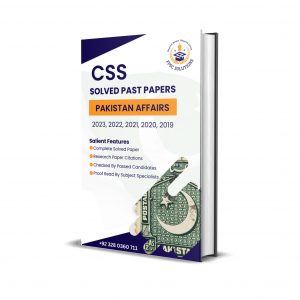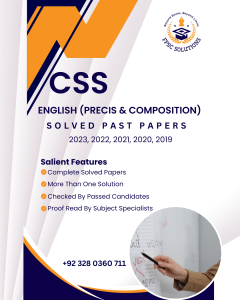The CSS Pakistan Affairs examination presents a significant opportunity for candidates to demonstrate their understanding of Pakistan’s history, politics, and socioeconomic challenges.
This guide helps you about how to solve CSS Pakistan Affairs 2019 paper and helps you understand how to approach each question and what examiners expect. With this preparation material, you will be better prepared to approach the CSS Pakistan Affairs 2019 exam confidently.
Get the free complete CSS Pakistan Affairs Preparation Material and prepare yourself for the upcoming css examination as well.
![CSS Pakistan Affairs 2019 Paper [Solved] 2 css pakistan affairs](https://fpscsolutions.com/wp-content/uploads/2024/08/CSS-Pakistan-Studies-2022-Free-Material.jpeg)
CSS Pakistan Affairs Past Paper 2019
Q2. Critically examine Congress Ministries of 1937. How far it is correct to suggest that it paved the way for a separate Muslim homeland in India?
Q3. How far the nature of Centre-Province relations has changed under various amendments to the 1973 constitution? Evaluate.
Q4. What major economic challenges are being faced by Pakistan? What recommendations do you suggest to deal with these issues?
Q5. “The population growth in Pakistan can erupt like an atomic bomb”. Comment.
Q6. What are the main causes of the energy crisis in Pakistan? What measures do you recommend to address it?
Q7. Critically analyze the key causes of delaying construction of DAMS in Pakistan. Give some suggestions to revert this collateral loss.
Q8. Efficient use of its natural resources can make Pakistan a prosperous nation. Discuss in the light of the present situation of Pakistan.
Comprehensive Solutions for Pakistan Affairs Past Papers 2019
-

CSS PAKISTAN AFFAIRS SOLVED PAST PAPERS 2023, 2022, 2021, 2020, 2019
₨ 999 – ₨ 2,999Select options This product has multiple variants. The options may be chosen on the product page
Guidelines for Attempting the Questions
Q. No. 2. Critically examine Congress Ministries of 1937. How far it is correct to suggest that it paved the way for a separate Muslim homeland in India?
- Examine Congress Ministries: Discuss the policies and actions of the Congress Ministries formed in 1937, focusing on their impact on the Muslim population.
- Paving the Way for a Separate Muslim Homeland: Analyze how these policies led to increased Muslim alienation and the demand for a separate homeland, highlighting key events and reactions from Muslim leaders.
Q. No. 3. How far the nature of Centre-Province relations has changed under various amendments to the 1973 constitution? Evaluate.
- Nature of Centre-Province Relations: Explain the relationship between the central government and provincial governments in Pakistan as defined by the 1973 Constitution.
- Changes through Amendments: Evaluate how various constitutional amendments have altered these relations, providing specific examples of changes and their impacts on governance.
Q. No. 4. What major economic challenges are being faced by Pakistan? What recommendations do you suggest to deal with these issues?
- Economic Challenges: Identify and discuss major economic issues facing Pakistan, such as inflation, unemployment, trade deficits, and debt.
- Recommendations: Suggest practical solutions to address these challenges, focusing on policy changes, economic reforms, and strategic investments.
Q. No. 5. “The population growth in Pakistan can erupt like an atomic bomb”. Comment.
- Population Growth Threat: Discuss the rapid population growth in Pakistan and its potential consequences, likening it to an atomic bomb.
- Comment: Provide an in-depth analysis of the social, economic, and environmental impacts of population growth and suggest measures to control it.
Q. No. 6. What are the main causes of the energy crisis in Pakistan? What measures do you recommend to address it?
- Causes of Energy Crisis: Identify the main causes of the energy crisis in Pakistan, such as poor infrastructure, lack of investment, and political instability.
- Measures to Address the Crisis: Recommend steps to resolve the energy crisis, including investments in renewable energy, policy reforms, and improving energy efficiency.
Q. No. 7. Critically analyze the key causes of delaying construction of DAMS in Pakistan. Give some suggestions to revert this collateral loss.
- Causes of Delays: Analyze the key reasons for delays in constructing dams in Pakistan, such as political disagreements, funding issues, and bureaucratic hurdles.
- Suggestions to Reverse the Loss: Provide suggestions to expedite dam construction, including policy changes, securing funding, and improving project management.
Q. No. 8. Efficient use of its natural resources can make Pakistan a prosperous nation. Discuss in the light of the present situation of Pakistan.
- Natural Resources and Prosperity: Discuss how efficient use of natural resources can contribute to Pakistan’s prosperity.
- Present Situation: Analyze the current situation of resource management in Pakistan and suggest ways to improve it, focusing on sustainable practices and strategic investments.
Mastering the CSS Pakistan Affairs 2019 examination requires a thorough understanding of historical and contemporary issues facing the nation.By utilizing CSS Pakistan Studies Solved Past Papers, guidelines structured and preparation material, candidates can enhance their preparation and improve their chances of success in the competitive examination.

![CSS Pakistan Affairs 2019 Paper [Solved] 1 css pakistan affairs](https://fpscsolutions.com/wp-content/uploads/2024/08/CSS-Pakistan-Affairs.png)
